Editor’s Note: This blog was co-authored by Abbie Abramovich, ICL Salmon & Steelhead Grassroots Associate, and Sarah Plane, a community organizer with ICL’s Salmon Mobilization Team.
June is National Rivers Month and Orca Action Month. One of these likely appeals to Idahoans more than the other, as pristine rivers are a regular source of pride for residents across the state. However, Idaho’s less apparent connection to Southern Resident Killer Whales (SRKW) in the Salish Sea is one worth celebrating and fighting for. Wild Snake River Chinook salmon from Idaho are a key part of the SRKW diet, but the decline of salmon has led to a similar decline for orcas.
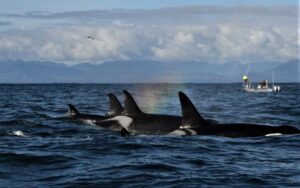
Salish Sea Orca
There are two predominant orca populations found within the Salish Sea. The more well-known population, known as the Southern Resident Killer Whales, is made of 3 family pods: Js, Ks, and Ls. This population has been in decline and has been on the endangered species list since 2005. The SRKW’ massive habitat ranges from Monterey Bay to as far north as SE Alaska. Southern Residents rely on salmonid species for 97% of their diet. Sightings in the Salish Sea used to be frequent and predictable during the summer and fall, as they intercepted salmon making their way to freshwater rivers.
Similar to many marine mammals, their movement is determined by their diet and food availability, which means over the years the SRKW have spent less and less time in the Salish Sea as their food source has been depleted. Historically, the SRKW had no problem finding food—the Columbia River Basin was one of the most productive Chinook salmon fisheries in the world, with up to 30 million salmon returning annually. The Snake River, the largest tributary to the Columbia, once produced half of the basin’s Chinook salmon. Today, only about 1% of the historic population returns—impacting all who rely on them, and making SRKW sightings fewer and less predictable.
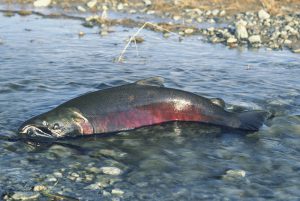
In stark contrast to the starvation problems and population decline of the SRKW, is the orca population previously known and referred to as Transients, but renamed Bigg’s after Canadian scientist Michael Bigg. This population thrives on the abundant food supply of marine mammals, including seals, sea lions, and porpoise. This population has a range that overlaps much of the SRKW range and has been seen as far south as San Diego, CA, however, the two populations do not commingle. You will not find large pods of SRKW mixed with Bigg’s, they do not travel or breed with one another, and their culture, pod structures, and behaviors are vastly different.
Today, the Bigg’s population is thriving with estimates over 400 members and several new calves added annually. If you find yourself around the Salish Sea and spot an orca from land or boat, it is highly likely that this is the population you are seeing. Washington Governor Inslee has signed new legislation to create a mandatory 1,000-yard vessel buffer around Southern Resident killer whales to protect the endangered population from vessel noise and disturbance, and most whale watching operations will not show SRKWs, but instead seek out Bigg’s sightings.
Where’s the food?
Central Idaho’s high mountain streams provide a cold water refuge and pristine habitat that Salmon desperately need. The Clearwater and Salmon river systems remain the best Chinook salmon habitat anywhere in the lower 48 states. But the fish cannot access this habitat—four dams on the lower Snake River in Washington are blocking them out, and have been driving wild salmon and steelhead toward extinction for decades.
The SRKW are feeling this impact. Research has shown that the death rate for Southern Resident orcas correlates with declines in Chinook salmon abundance. In December 2020, the Southern Resident population declined to a 40-year low of 74 individuals. This was more than a 25% decline from the observed peak population size of 98 individuals in 1995, 10 years before they were listed under the Endangered Species Act.
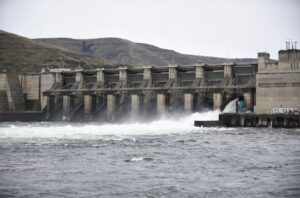
Orca Action Month: Toxics and connecting the dots
This year’s Orca Action Month centers around the theme of toxics. Toxic pollution and contaminants found in the environment impact us all. Virtual and in-person events (mainly held in or around the Salish Sea) this month will help inform people on many of these topics, including the impact that polluted habitat has on Salmon runs, the types of toxics and sources of toxics in the Salish Sea, and ultimately how these toxics contribute to risk factors facing these two orca populations.
Readers may be asking themselves how this “toxic talk” connects to their concerns of Snake River Salmon returning to the pristine habitat of Idaho. While toxins are found in orca from both populations, they are found in higher concentrations in Bigg’s orca, due to them eating higher up on the food chain. And yet, the Bigg’s population is thriving—with far fewer miscarriages and calf deaths than in the SRKW population. The difference is food availability. As the SRKW starve, their body relies on fat to survive, the stored toxins in their blubber get released into their system as a result. This causes miscarriages, leaches toxics to newborns through milk, and causes deaths in adults. The Bigg’s, having an abundance of food supply, do not release their higher concentrations of toxics into their system, resulting in a growth of population through healthy, well-fed calves and mamas.
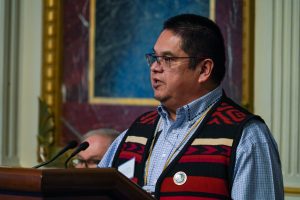
People are hurting, too
Orcas aren’t the only ones hurting. There’s many other stakeholders that depend on these fish—anglers, outfitters and guides, river communities, and Tribes that have been promised access to healthy populations of these fish in treaties and other agreements with our federal government.
Tribal communities across the Northwest have been leading the calls for restoration of salmon and orcas across the region. Last year, Jay Julius, former Chairman of the Lummi Nation and the Founder and President of Se’Se’Le wrote about how salmon, orca, and the Lummi Nation are being managed to extinction.
“State and federal agencies will tell us how they are doing their best to manage the salmon. But, at least in our view, what’s happening is that the Lummi Nation is being managed to extinction—just like the salmon and the Southern Resident killer whales. If that sounds harsh, it is. Because the hard reality is that ecocide leads to genocide. Our salmon and orca relatives are being dishonored, along with the rights and promises made by the settler government to the Salmon Nations of the Xw’ullemy just six generations ago.”
This spring, youth from across the Northwest traveled to DC together to urge federal leaders to breach the four lower Snake River dams to save salmon from extinction, honor Tribal treaties, and heal these ecosystems. Youth Salmon Protectors met with representatives from Washington, Oregon, Idaho to share why this issue is important to them. Their calls for action were united and focused on climate, justice and investing in their future.
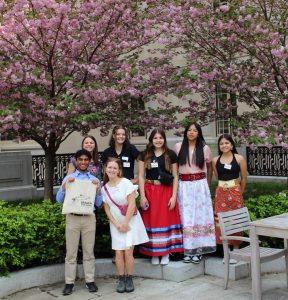
Meanwhile, back in Idaho and 456 miles from the ocean is the most inland seaport on the west coast in Lewiston, Idaho. The dams on the Columbia and Snake River create a manipulated river system that allows barges to ship wheat and other valuable products to the Pacific and foreign markets. However, the four dams on the Snake River that make this navigation system possible create conditions that have contributed to the demise of Chinook salmon and the starvation of Southern Resident Orcas.
The irony of the sign in Lewiston that thanks passersby for “visiting Idaho’s only seaport” while the dams that create that seaport are driving one of the sea’s most iconic species to extinction cannot be ignored any longer. Elected officials must invest in resources to replace the services of the dams and restore wild salmon, steelhead, and orcas to the Pacific Northwest—honoring Tribal promises and making communities whole.
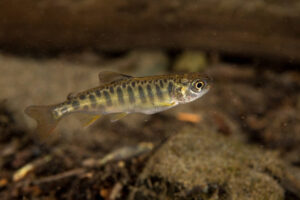
An opportunity to tell federal leaders it’s time for change
Orca Action Month represents a great opportunity to highlight the challenges Southern Resident Orcas face to our elected officials, and to let them know that we care about salmon, orcas, and Tribal justice. At the link below, take action by urging our Congress members to support investments to recover salmon and steelhead in the Columbia River and its tributaries, leading to a better future for salmon, orcas, and people alike!
